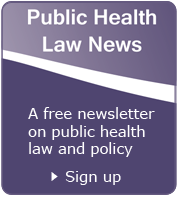Healthcare-Associated Infections
Laws encouraging the prevention and reduction of healthcare-associated infections (HAIs), infections acquired during the course of receiving treatment for other health conditions, have emerged and expanded in states since 2004. These laws address requirements for state health departments, healthcare facilities, and healthcare providers to promote best practices in HAI prevention. In particular, they address
- Authorities granted to state health agencies
- Definitions for the infections and facilities covered under state laws
- HAI advisory councils
- Pilot phases for state programs
- Reporting requirements for facilities
- Licensure and training requirements for facilities and providers
- Financial incentives and disincentives
- Protection of HAI data
The coordination of state statutory requirements and federal incentives has created an environment where facilities, providers, and health departments can work together to reduce the burden of HAIs in states.
Menu
-
Menu of Selected Provisions in Healthcare-Associated Infection Laws [PDF - 2.33MB]
A resource that helps attorneys and public health practitioners understand the variety of provisions in state HAI laws. The Menu provides examples from state statutes related to the range of policy topics found in HAI laws. The Menu is a companion to the CDC-ASTHO Policy Toolkit, Eliminating HAI—State Policy Options, published by CDC and the Association for State and Territorial Health Officials in April 2011. -
Legal Epidemiology in Practice: The Example of Healthcare-Associated Infections [PDF - 241KB]
This poster explains legal epidemiology, which is the study of law as a factor in the cause, distribution, and prevention of disease and injury, and legal epidemiology’s application in studying and understanding healthcare-associated infections. Ramanathan T. Legal Epidemiology in Practice: The Example of Healthcare-Associated Infections. Poster session presented at the American Public Health Association’s Annual Meeting. Chicago, IL: Oct. 31–Nov. 4, 2015.
Articles
-
Outpatient Settings Policy Options: Four Key Policy Elements for Best Practices [PDF - 1.6MB]. This document and accompanying worksheet is designed to assist health departments and policymakers to assess current policies relating to outpatient settings in states, localities, and territories, as well as consider options for improving practices. The included elements reflect CDC, workgroup, and health department experience with healthcare-related outbreaks and quality improvement.
-
Impact of Laws Aimed at Healthcare-Associated Infection Reduction: A Qualitative Study. This article and accompanying commentary describe a qualitative study of the impact that laws addressing healthcare-associated infections have on health departments, healthcare facilities, and the public. The study was funded through a CDC cooperative agreement with the Association of State and Territorial Health Officials with assistance from Public Health Law Research and with researchers at Columbia University School of Nursing. Impact of laws aimed at healthcare-associated infection reduction: a qualitative study. Patricia W Stone, Monika Pogorzelska-Maziarz, Julie Reagan, Jacqueline A Merrill, Brad Sperber, Catherine Cairns, Matthew Penn, Tara Ramanathan, Elizabeth Mothershed, Elizabeth Skillen. BMJ QUAL SAF bmjqs-2014-003921. Published Online First: 4 June 2015 doi:10.1136/bmjqs-2014-003921.
-
Law as a Tool to Promote Healthcare Safety [PDF - 106KB]
Describes legal sources and principles that impact responses to unsafe injection practices that result in infection and injury. In particular, this article aims to inform healthcare providers and healthcare facility leaders about the statutory, administrative, criminal, and tort law implications related to preventable harms from unsafe injection practices. Published in Clinical Governance: An International Journal 2014;19(2): 172–80. This copy was formatted to include full legal citations in the footnotes. -
The Emergence of Law to Address Healthcare-Associated Infections [PDF - 243KB]
An overview for health lawyers who seek to understand the landscape of healthcare-associated infection (HAI) laws and policies in order to advise healthcare clients, public health departments, and consumers regarding their responsibilities for HAI prevention. The article references tools and resources published in 2011 and 2012 by the Public Health Law Program in partnership with the Division of Healthcare Quality Promotion (DHQP) in the National Center for Emerging and Zoonotic Infectious Diseases and the Association for State and Territorial Health Officials and its partners. A sample of these resources is also available on the DHQP Policy Page. Published in AHLA Connections, v. 16, n.8 (Aug. 2012). © 2012 American Health Lawyers Association
Toolkits
-
Improving Your Access to Electronic Health Records During Outbreaks of Healthcare-Associated Infections: A Toolkit for Health Departments. Through a collaboration with CDC’s Division for Healthcare Quality Promotion, the Association of State and Territorial Health Officials, and the Keystone Center, the Public Health Law Program examined the use of law and legal tools to improve access to electronic health record (EHR) systems in healthcare facilities during outbreaks. This toolkit is designed to help professionals working in local, state, and territorial health departments work with healthcare facilities (e.g., hospitals, outpatient clinics, surgical centers, etc.) during outbreaks, including outbreaks of healthcare-associated infections, to secure access to EHR systems, facilitate outbreak investigations, and stop the spread of disease.
-
Disclaimer: Information available on this website that was not developed by the Centers for Disease Control and Prevention (CDC) does not necessarily represent any CDC policy, position, or endorsement of that information or of its sources. The information contained on this website is not legal advice; if you have questions about a specific law or its application you should consult your legal counsel.
- Page last reviewed: August 19, 2016
- Page last updated: August 19, 2016
- Content source:




 ShareCompartir
ShareCompartir



